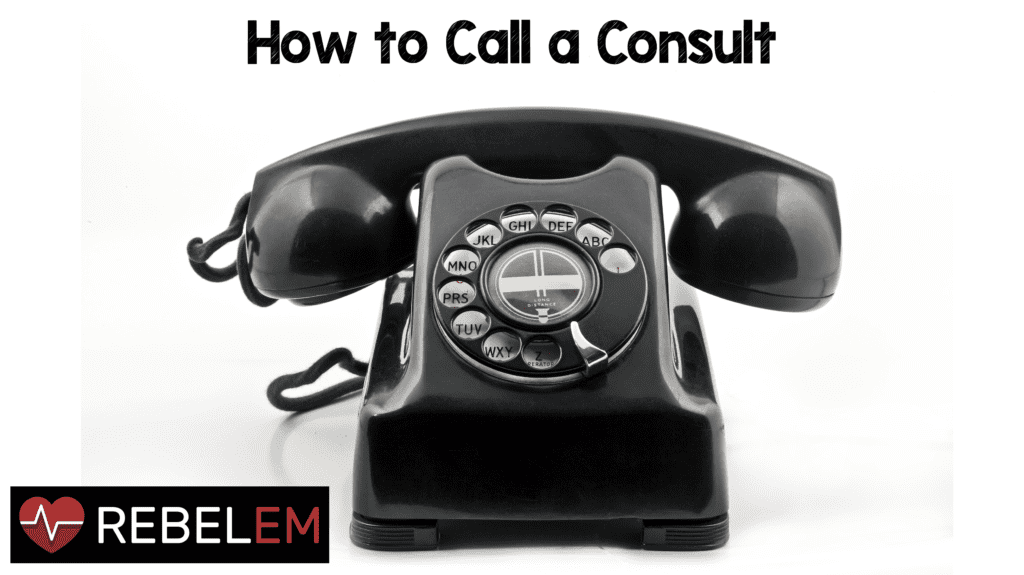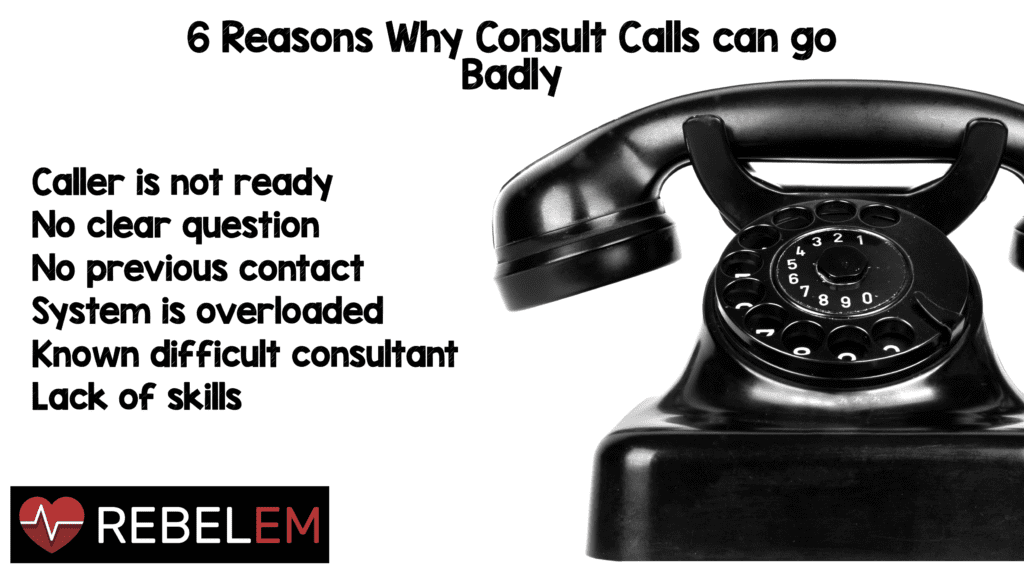

Consider these two consult calls for a healthy 18 year old male with appendicitis:
- Dr Surgeon, this is Rob Bryant, I am calling you about an 18 year old male with a 2 day history of abdominal pain. He was seen several years ago in the emergency department for gastroenteritis, but has never had this amount of pain before. He has had 3 episodes of vomiting, and 2 episodes of non-bloody diarrhea. Today he awoke with some pain in his right lower quadrant that has progressively worsened throughout the day. His past medical history is negative, he is on no meds, and has no allergies. His family history is significant for his brother having an appendectomy at age 15. On exam he has a BP of 120/80, heart rate of 90, Respirations of 16 and temp of 37 degrees celcius. He has a normal heart and lung exam, and had a lot of abdominal tenderness, with moderate RLQ tenderness with some guarding. CBC showed a normal hemoglobin and hematocrit, platelets were 150 and white cell was 12. He has received some iv morphine and zofran. We did a CT of his abdomen that showed an 8mm appendix with stranding, appendicolith and no signs of rupture….
- Dr Surgeon, this is Salim Rezaie, Thank you for taking my call. I am calling you about a healthy 18 year old male with acute appendicitis with no sign of rupture on CT. His name is John Smith, DOB 2/4/1998. He has had 1 day of abdominal pain and significant RLQ pain on exam, he is non toxic appearing and has a white count of 12. He has received 1g of invanz and is NPO since 0800 this morning. Can I tell you anything else about this patient?
In case one, the story meanders like a bad murder mystery, and the surgeon has no idea why they are being called until the end of the call. The reason for this is, they do not know why they are being called and what pieces of data they are being given are important, which will lead the consultant to ask for some of the data to be repeated, which can frustrate the caller.
In case two, Salim leads with the reason for the call, and then gives only the pertinent information to the surgeon. The surgeon knows up front why he/she is being called, and at the end of the call is given the opportunity to request more information if needed. If you were the surgeon woken from a dead sleep at 2 am with these calls which one would you rather receive?
Six Reasons Why Consult Calls can go Badly (From Nadim Lalani MD)
1. Caller is not ready
We need to have our ducks in a row when the consultant returns our call. This means having our ‘one liner’ introductory sentence to hook the listener, and having all relevant (and accurate) patient data readily available.
2. No clear question
We need to know what we need from our consultant. If we don’t know what we want, it will be hard for our consultant to know what we want. “I am calling for assistance with outpatient follow up,” vs “I am calling to admit this patient onto your service.”
3. No previous contact
In a large hospital system it is not unusual to have never interacted with the consultant. Making good first impressions will help tremendously. Having a goal of only calling for appropriate reasons will also endear your consultants to you.
4. System is overloaded
Any time a consultant receives a call from the ED it will typically mean more work for them. Making an efficient and factually correct call will make your consultants day less miserable. It also takes time to build rapport with a consultant through multiple interactions, but only one bad interaction to lose their trust.
5. Known difficult consultant
In medicine we are unfortunately exposed to some consultants with significant personality issues. The only good way to deal with this is to exude professionalism, courtesy, and to not sink to their level if the conversation deteriorates.
6. Lack of skills
We spend very little time training our residents and students in the best way to call a consult. Calling a consult is a different animal to presenting a case in a teaching facility.

Evidence on Calling Consults
There is a dearth of literature on calling consults in the emergency department. The most useful article is from Kessler et. al. in 2012. [1]
They perform a qualitative analysis of consult calls with consultants and emergency department staff to see what they like, and dislike about the way consult calls occur in their facility. A 10 question survey was sent to emergency physicians, and to specialists, then follow up semi-structured, 1 hour group interviews were conducted to further explore themes that were identified from the surveys.
The analysis was based on three questions:
- What skills lead to a successful consultation, and should be part of every consultation?
- What skills, or lack there of, lead to an unsuccessful consultation?
- How does one avoid, or resolve conflict in consultation?
The three themes that emerged from all questions were organizational skills, interpersonal and communication skills, and medical knowledge. This review led to a 5C’s model of calling a consult, adapted from a business model of efficient communication.
5 C’s Model of Calling a Consult
Contact
Introduction of consulting and consultant physicians. Building of relationship.
‘This is Rob Bryant, I am calling you from the Emergency Department. Dr Jones we have you listed as our on call surgeon today, is this correct?’
Communicate
Give a concise story and ask focused questions.
Ideally a one sentence delivery to ‘hook’ the listener, allowing them to know what data points will be important to them as they hear the rest of the story.
Core question
Have a specific question or request of the consultant. Decide on a reasonable time frame for consultation.
‘I am calling for a consult in the ED’, ‘I would like prompt outpatient follow up for this patient’.
Collaboration
A result of the discussion between the emergency physician and the consultant, including any alteration of management or testing of patients status.
Closing the loop
Ensure that both parties are on the same page regarding the plan and maintain proper communication about any change in the patients status.
‘Dr Smith, thank you for taking my call, I will arrange for a bed upstairs for the patient to be admitted to your service.”
Prospective Testing of the 5 C Model
Kessler and colleagues have tested the 5C model in a randomized fashion comparing EM residents who have and have not received training in the 5C concept. [cite source=”pubmed”]22905961[/cite] (Free, open access.)
A Prospective, Randomized, Controlled Study Demonstrating a Novel, Effective Model of Transfer of Care between Physicians: The 5 Cs of Consultation
43 EM and EM/IM residents were randomized into two groups. The intervention group received training on the 5 C’s model of consultation. Each group then placed two consult calls to a standardized consultant, and were rated using a seven item, five point global rating scale (GRS).
The first consult call was an ‘intervention consult’ where a specific intervention was needed. In this case it was a patient requiring admission for acute appendicitis.
The second consult call was a ‘specialist recommendation’ consult, with a schizophrenic patient requiring consultant advice and guidance for further care.
Results
- The intervention group had significantly higher GRS scores (4.1 vs 3.5, p<0.0001). A secondary analysis of the recordings suggested that those calls that used the 5C model received higher GRS scores
- There was no difference in GRS score based on year of training (PGY 1 or 2, vs PGY 3 or greater)
- The intervention groups length of consult calls were shorter than the unstructured group with an average length of call of 107 seconds (95% CI 96-118 seconds) vs 125 seconds (95% CI 115-135) p <0.018
- When the consult calls were evaluated by specialists the intervention group again received higher GRS scores than the unstructured group
- Blinded psychiatrist rating of calls had a mean GRS of 4.1 vs 3.38 (p = 0.029)
- Blinded surgeon rating of calls for the surgery case had a mean GRS of 4.1 vs 3.29 for the unstructured group.
Other Studies
Kessler and colleagues have also performed a multicenter randomized controlled trial to evaluate the 5C’s model in medical students [2]. The intervention group had higher GRS scores, and better 5C checklist scores than the unstructured group, and reported improved confidence in their ability to call consults following both asynchronous, and live 5C training.
The Bottom Line
- Learning to call effective consults that will facilitate faster dispositions for our patients is an essential skill for every emergency physician to master
- Using the 5C framework is an effective way to both model, and teach effective consultation
- Leading your consult call with a specific question will make the call a lot easier. If you are about to deliver 20 data points, and your consultant only needs 5, they will be able to pick those 5 from the 20 you offer them, but only if they know the question up front. This will save you from having to repeat these data points to the consultant
- More attention needs to be paid to the way we arrange consultations, as they can be a significant source of frustration, conflict, and job dissatisfaction if not performed efficiently and correctly.
References:
- Kessler C et al. Consultation in the Emergency Department: A Qualitative Analysis and Review. J Emerg Med 2012. PMID: 21620608
- Kessler CS et al. The 5Cs of consultation: Training Medical students to Communicate Effectively in the Emergency Department. J Emerg Med 2015. PMID: 26250838
Other FOAMed resources
- Nadim Lalani at ERMentor: Requesting Consultations Using Kessler’s 5C’s Model
- Lauren Westafer at The Short Coat: Sweating Bullets and Killing ’em with Kindness – Calling a Consult
Post Peer Reviewed By: Salim Rezaie (Twitter: @srrezaie)
The post How to Call a Consult appeared first on REBEL EM - Emergency Medicine Blog.
